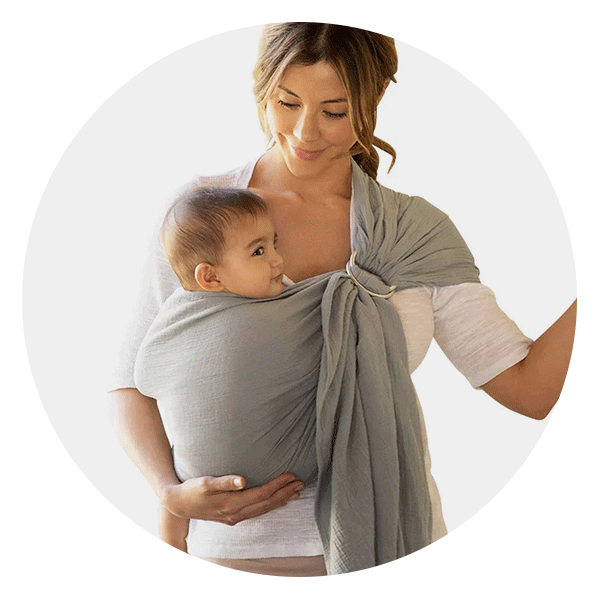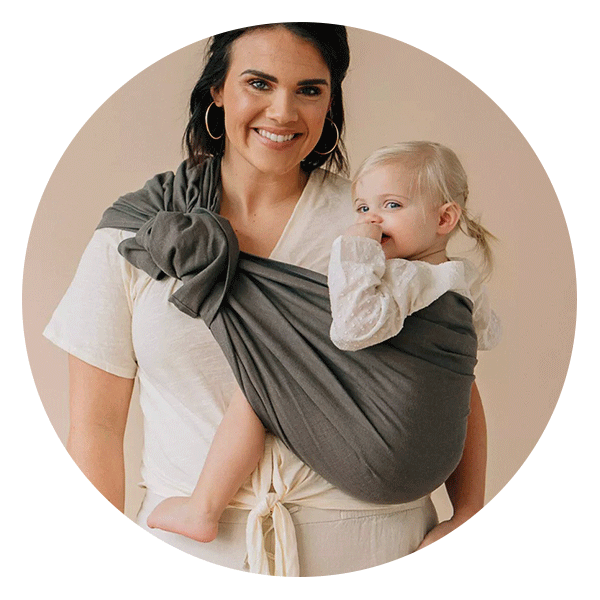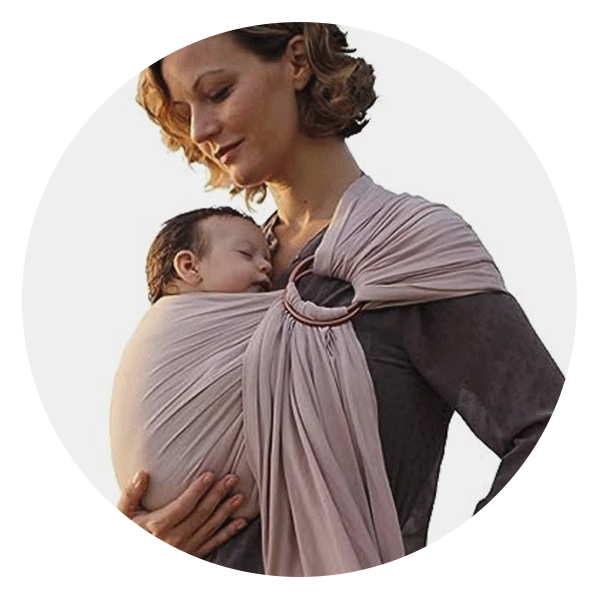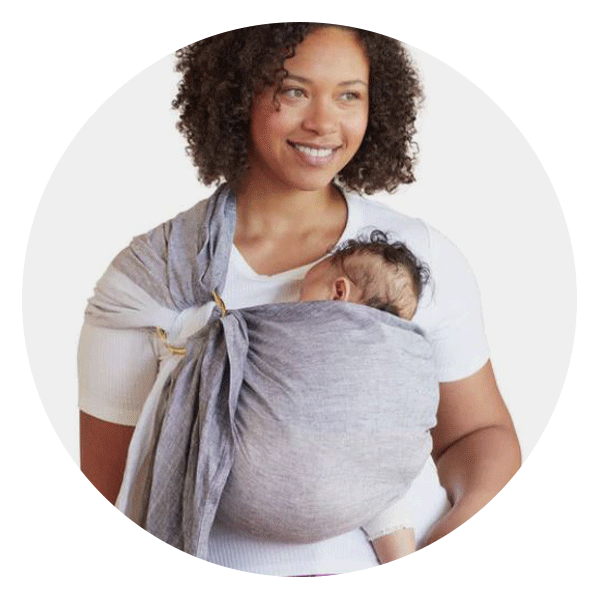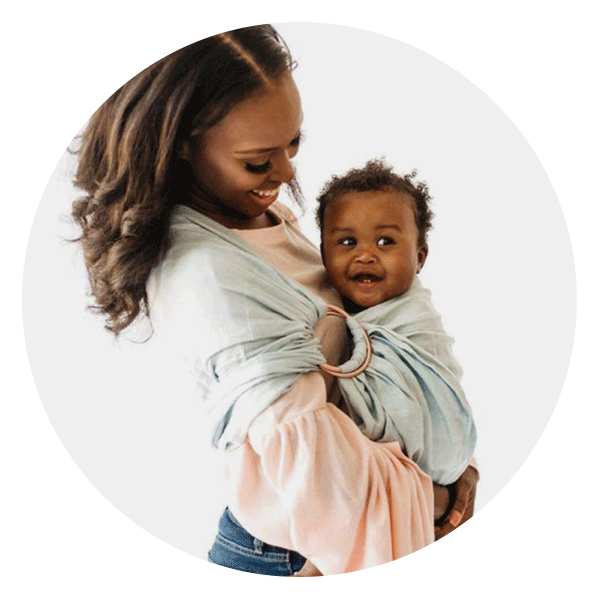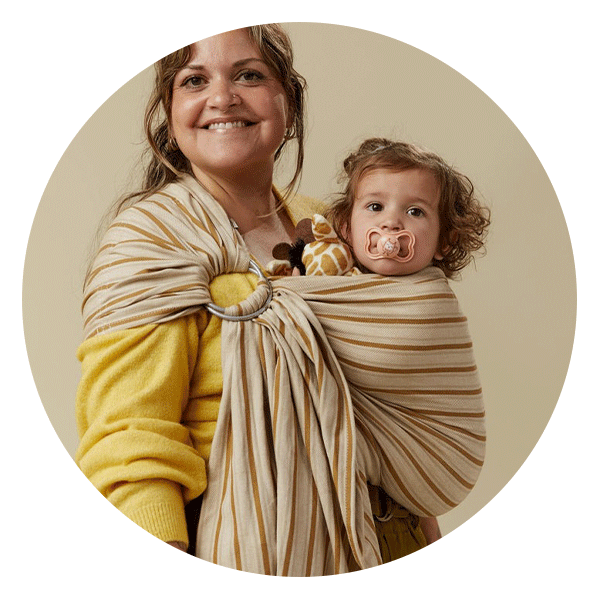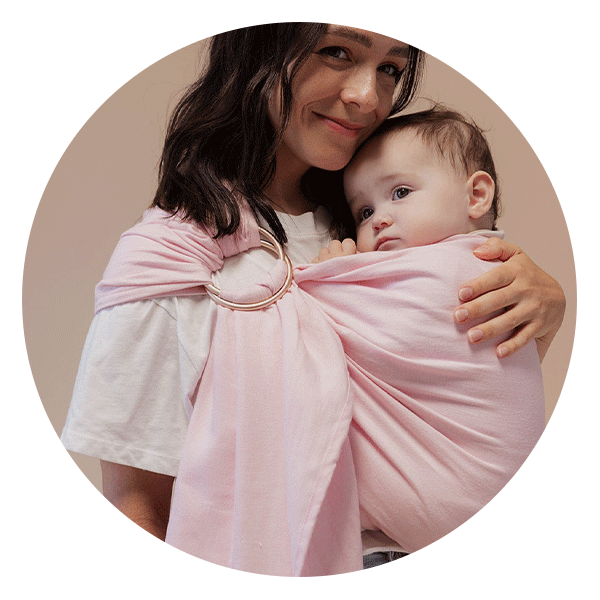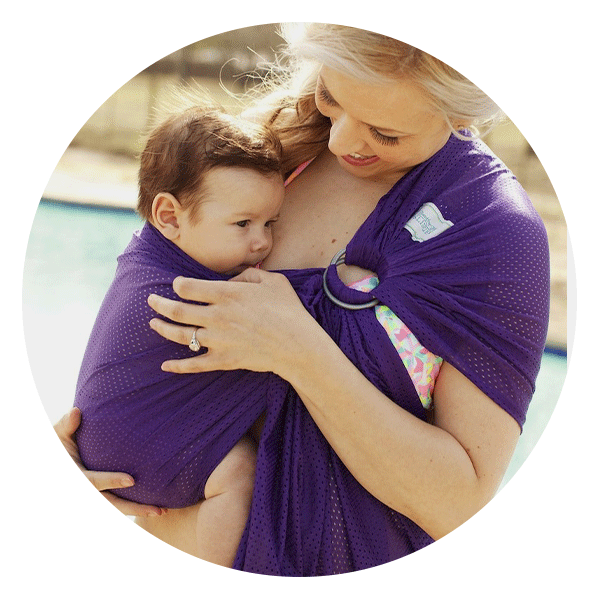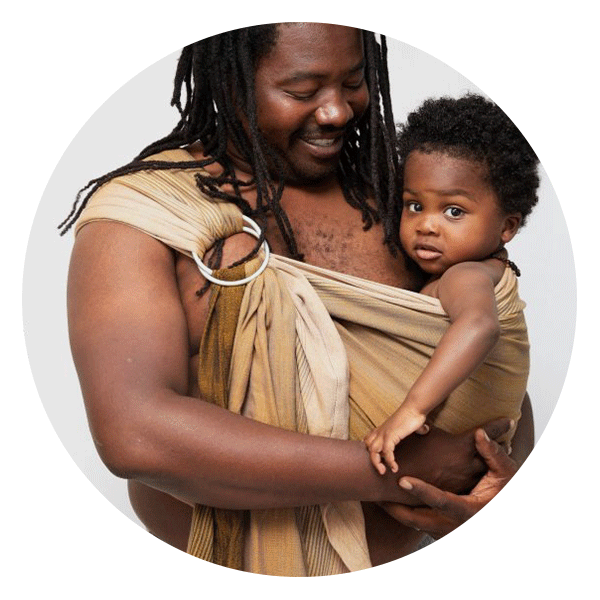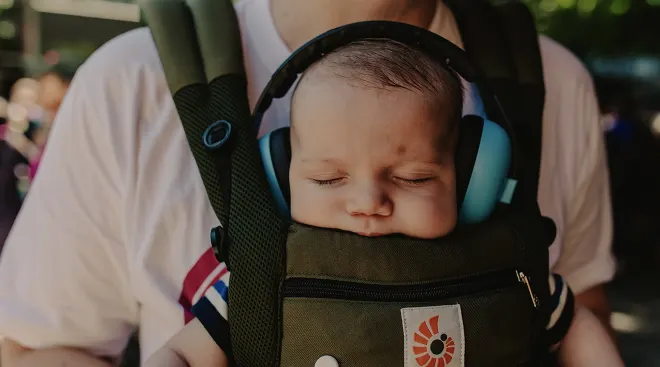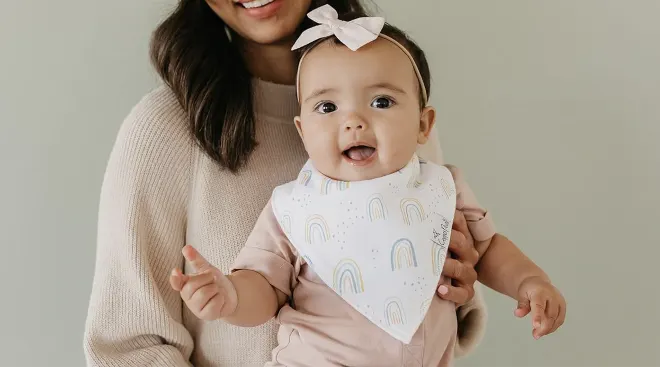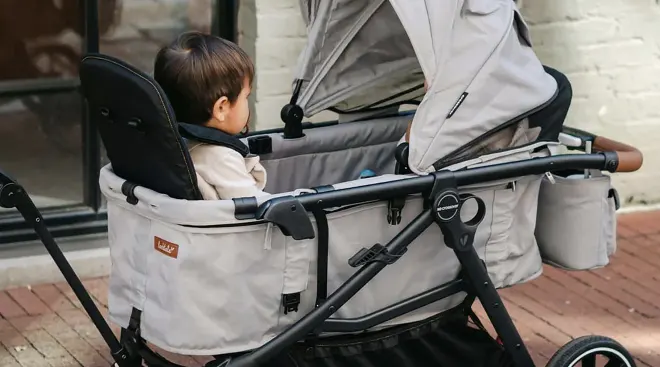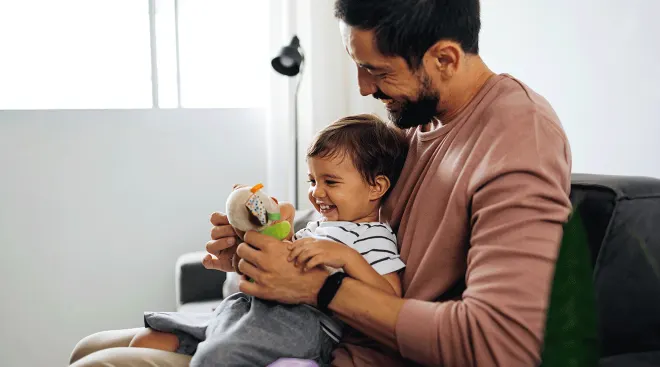The Best Ring Sling Baby Carrier Styles to Keep Baby Close
Babywearing is basically a necessity. After all, you’ve probably got a lot on your to-do list that requires free hands! Keeping your little one in a baby sling close to your chest helps comfort them and frees you up to get things done. But the practice is also valuable beyond the infant stages—which is why “toddler wearing” is a thing. Sometimes, it’s just more convenient to carry a tot than to make them trot on their own. While there are multiple types of infant carriers (and toddler carriers at that), many moms opt for a comfy, sturdy ring sling baby carrier to keep their child close. They’re less bulky than more structured styles and easier to use than baby wraps since they come with—you guessed it—rings that help them stay fastened. Ease of use isn’t the only benefit though—a baby sling can help you form a physical bond with your child, as your bodies will be cozily pressed together whenever you wear one. Plus, the ample fabric and placement of a ring sling baby carrier can make discreet breastfeeding a breeze. Ready to decide if a ring sling is the right choice for you? Read on for the full info, then shop our picks of the best ring sling baby carriers on the market.
You’ve probably seen a ring sling “out in the wild” a couple of times and wondered what it was and how it worked. To answer your question, we chatted with Alex Sparrow, founder of The Well Carried Child and a certified babywearing consultant based out of Raleigh, North Carolina. “A ring sling baby carrier is a horizontal piece of fabric with rings attached to one end to secure the fabric around the caregiver’s body, which creates a pouch to hold the baby,” she explained. There tend to be no buckles, snaps or fasteners; the rings alone ensure a tight, anchored fit, which makes the feel a lot more flexible and fluid.
A ring sling baby carrier is a great choice for new parents in the fourth trimester when you’re starting to get into a routine and want to establish a close bond. It makes sense: Baby wants to be connected to you; they want to hear the heartbeat that was familiar to them in the womb and feel the warmth and tenderness of your touch. With a ring sling that hugs their tiny body ever-so-gently—and pulls them close to your heart—they’ll experience a sense of calm that can ease their fussiness, lull them to rest and even facilitate successful nursing sessions (if that’s your feeding journey!).
Wondering if a ring sling is the same as a baby wrap? While both soft carriers offer a quick and easy way to get your infant on and ready to ride for whatever comes next (be it a nice walk outside or errand running), they differ in how they’re worn and distribute baby’s weight. A ring sling baby carrier is worn diagonally over the body—from shoulder to opposite hip and has—at most, three wearable positions: front, hip and potentially back (this last option is only acceptable after baby turns one). A wrap, on the other hand, is usually wrapped around your shoulders and across your torso in infinite configurations that support front, hip and back carrying. Both carriers free up your hands, but, with a ring sling, the weight can be felt on your one shoulder, while a wrap carrier evenly distributes the weight across your hips and shoulders. “A ring sling is one type of baby carrier, just like there are different types of shoes better for different activities,” explains Sparrow. She continues, “a baby wrap, which can be made of two-way stretchy or woven fabric, is a different type of baby carrier, not any better or worse.” All in all, which style you choose to use largely comes down to personal preference.
First and foremost, trust your intuition. Consider your ring sling an extension of your wardrobe and opt for one that fits your style and feels comfortable. You’ll want it to be adjustable to your body shape and accommodate your infant’s size. Though most ring sling baby carriers can safely hold infants from 8 pounds all the way up to 35 pounds, you’ll also want to be sure you’re not taking chances with a newborn who is too small or a toddler who is maxing out the weight capacity. Here, a few other features to keep in mind:
-
Adjustability. For more straightforward adjustments, Sparrow recommends ring sling baby carriers with different colors on the top and bottom edges or horizontal stripes. Feel free to shop around a little (not many ring sling brands are available in stores, so you’ll likely need to shop online) to try out different fabric lengths and sizes; you can always return what you don’t like. After all, what feels best on your body might differ from what feels best to your friend, especially if you (and your kids) are shaped differently. To this end, some brands will offer you a complimentary fit session with one of their style consultants after you purchase a ring sling. Still feeling a bit stuck? “Sometimes you may need an extra pair of hands, such as a certified babywearing consultant, like myself,” Sparrow adds. This way, you can become more familiar with the finer details of babywearing to ensure you and baby are comfortably supported.
-
Breathability. With newborns, the natural need for a womb-like atmosphere is very apparent in the first few weeks of life. But when you’re using a fabric carrier, there’s a fine line between cozy and too-confined. Look for slings crafted from materials like cotton, linen, silk and/or bamboo which are more breathable fabrics and help with airflow.
-
Compliance. The best baby ring sling carriers aren’t only parent-approved but also have institutional approval. Turn to ASTM- and CPSC-certified products for added peace of mind. Both parties have put out ring sling safety guidelines. You also may want to scope out slings with a “hip-healthy” sign-off from organizations like The International Hip Dysplasia Institute (IHDI).
Ready to start your search? We’ve rounded up some of the best ring slings on the market, like a fashion-forward baby ring sling carrier, a breastfeeding-friendly option and even a versatile water ring sling for the beach and other sunny summer adventures. To help narrow your choices down, we’ve asked The Bump community—real parents, just like you—to tell us about the ring slings they use with their babies. Keep reading to check out their thoughts, alongside our top picks for every lifestyle and budget.
Overall best ring sling baby carrier
- Our product tester loved how simple it was to thread the sling
- Inclusive size fits a wide range of parents
- Made from high-quality, durable materials
- Some say they wish the rings were easier to adjust while babywearing
At the top of our list is the Moby Ring Sling, which offers ultimate comfort to you and baby. It’s made from lightweight, breathable cotton that’s super gentle on sensitive skin, encouraging bonding and breastfeeding. Simple to slip on and comfortable enough that you can wear it for long stretches of time, this baby sling is stylish, breathable and durable. With it, you’ll be able to carry baby on your front or your hip, depending on your preferences. It’s easy to see why this pick is a parent favorite, thanks to its chic style, versatile design and easy-to-use features.
Dimensions: 84.3” (L) | Weight: N/A | Material: 100% cotton | Weight capacity: 8 to 33 lbs.
“I absolutely love the style of this carrier. The gauze cotton fabric has the feel of linen that is lightweight and yet feels durable and washes beautifully.” – Christine, mom of a two-month-old and a three-year-old
Best ring sling baby carrier for newborns
- Supports three carrying positions: front, hip or back
- Longer length is available for tall or plus-size baby wearers
- Hypoallergenic fabric is gentle on sensitive skin
- Acknowledged as hip-healthy by the IHDI
- If you have sensitive skin, the modal option may be a better fit
The hypoallergenic and temperature-regulating ring sling baby carriers from WildBird are perfect for experienced and novice babywearing parents alike. Available in dozens of fun colorways, it works as a newborn ring sling but also holds up to 35 pounds. The brand offers adorable mommy-and-me matching ring sling minis for dolls, which makes them ideal for parents with older children who might get jealous of all the attention their new sib’s been getting. (They’ll be too distracted acting like a grownup and toting around their favorite stuffed animal to care.) A final bonus? They’re made by moms working from home, so you can count on them to meet the specific needs of motherhood’s early days.
Dimensions: 74” (L) or 90” (L) | Weight: N/A | Material: 100% linen | Age range: Newborn+ | Weight capacity: 8 to 35 lbs
Best baby sling for breastfeeding
- Encourages baby to sit in the hip-healthy M-position
- Extra fabric doubles as a nursing cover
- Durable yet soft material is antibacterial, UV reflective and triple-stitched at the shoulders
- Reviewers say there was a learning curve when using it at first
When a product has a high rating after thousands of reviews, you know it must be good. We’re guessing moms and dads love this ring sling baby carrier for various reasons, like its premium unwelded and lead-free aluminum rings, the silky smooth bamboo-linen fabric and the trendy color options. What also stands out is how nursing-friendly it is; while breastfeeding on the go, use the extra fabric as a built-in nursing cover for added privacy. This baby sling harnesses infants naturally in the M-position so that their hips can develop properly while keeping both of you comfortable. What’s more, the front carry position that massages baby’s belly might just be the reflux-relaxer and digestion-improving solution you’ve been waiting for. All of those
Dimensions: N/A | Weight: 1.1 lbs. | Material: Bamboo-linen blend | Age range: N/A | Weight capacity: 8 to 35 lbs
Best lightweight ring sling baby carrier
- Can be worn in three different carrying styles
- Reviewers love the removable pouch
- Contrasting edges for straightforward adjustments
- Acknowledged as hip-healthy by the IHDI
- Some say they wish the fabric were softer
- Only available in two colorways
This ring sling baby carrier is similarly made from premium-quality, hypoallergenic linen that lets you pull your child close as you free up your hands for other things. Designed with contrasting thread along one edge of the sling, you can easily identify each hem and adjust the fit seamlessly. This hip-friendly option is suitable for babies ranging from 7 to 33 pounds, so you’ll most likely be able to wear it as soon as you come home with your newborn and right on through their first few steps. Better yet, this ring sling baby carrier seamlessly converts to three carrying positions—fetal, classic and hip—to meet your and baby’s changing needs.
Dimensions: 80” (L) x 0.1” (W) x 26” (H) | Weight: N/A | Material: Linen | Age range: N/A | Weight capacity: 7 to 33 lbs.
Most stylish ring sling baby carrier
- Plus-size reviewers say this ring sling is super comfortable
- Features two pockets for everyday essentials
- Safe to go in the dryer
- Some reviewers wish the material was softer
You might have shopped at Kyte Baby before for their adorable infant sleepwear, but did you know the brand also makes lush ring slings too? Not only is this ring sling carrier stretchy and breathable for baby’s delicate, sensitive skin, but it also has a feature to delight every parent: Pockets! The fabric is made from 100 percent pre-washed linen (which is environmentally friendly to boot) and holds infants up to 35 pounds. And check out those blush-toned rose gold rings—they go with each color in Kyte’s earth-toned palette.
Dimensions: 80” (L) | Weight: N/A | Material: 100% linen (sling), 100% aluminum (rings) | Age range: N/A | Weight capacity: 8 to 35 lbs.
Best patterned ring sling baby carrier
- Offers multiple carry positions
- User-friendly design is great for new and experienced baby wearers alike
- Available in two lengths and in a range of aesthetically pleasing styles
- Reviewers love how soft it is
- Some colorways may have limited stock
Looking for a baby sling carrier featuring funky patterns? Well, Baby Tula offers ringed wraps in a whole bunch of quirky, kaleidoscopic colors. Like most of the ring slings on our list, they’re made for babies weighing anywhere from 8 to 35 pounds, and they come in standard and long lengths for a perfect fit. Add an intuitive, fast and easy try-on experience—plus quick-to-make adjustments for short or long endeavors—and you’ve got a patterned style you’ll want to wear out on repeat.
Dimensions: 77” (L) or 87” (L) | Weight: N/A | Material: 100% cotton | Age range: Newborn+ | Weight capacity: 8 to 35 lbs.
Best modal ring sling baby carrier
- Super-soft fabric available in several trendy colorways
- Longer length is available for tall or plus-size baby wearers
- Acknowledged as hip-healthy by the IDHI
- Not all colorways are available in the longer length
On the hunt for a ring sling baby carrier that’s luxuriously soft for you and baby? Look no further than the WildBird Modal Sling. As the name implies, it’s crafted from an ultra-comfortable, stretchy blend of Tencel modal and linen. This option offers all of the same benefits as the classic linen style—the only difference is the fabric. Choose between the standard or long length, depending on your preferences, then pick your favorite colorway and ring color for a personalized ring sling baby carrier that matches your everyday style.
Dimensions: 74” (L) or 90” (L) | Weight: N/A | Material: 75% lyocell modal/25% linen | Age range: N/A | Weight capacity: Up to 35 lbs.
Best ring sling baby carrier for beach days
- Mesh design is water-friendly
- Available in three sizes and 14 colors
- Slightly lower weight capacity than other options on our list
- Fabric won’t protect against harmful sun rays
Are you taking your first trip (somewhere warm, we hope!) with baby and searching for a vacation-worthy carrier? This baby ring sling has got you covered. Thanks to its mesh material, you can bring it to the pool or beach without worrying about water weighing it down. It fits babies 8 to 30 pounds, and comes in multiple colors. Another bonus: The clever design is made right here in the US by moms, for moms. Plus, it meets ASTM safety standards, which is always something to consider when buying a ring sling baby carrier.
Dimensions: 66” (L) | Weight: 8.8 oz. | Material: Polyester (sling), aluminum (rings) | Age range: N/A | Weight capacity: 8 to 30 lbs.
Best padded ring sling baby carrier
- Has a zippered pocket for everyday essentials
- Long tails can be used as a sun shade or for nursing coverage
- Available in multiple solid, stripes and ombre colorways and two lengths
- May take time to figure out how to use it
This ASTM- and CPSC-compliant ring sling baby carrier boasts lightly padded shoulders for extra comfort and beginner-friendliness—because babywearing can put a lot of pressure on parents and caregivers (literally and figuratively). Maya Wrap’s sleek padding cushions the shoulder to sit flat with no bunching or digging at the neck (phew!) and an always-supportive hold for infants and toddlers up to 35 pounds. There are no painful pressure points, no shifting in the shoulder fabric and no bulk, which is great for when you’re bustling through the day. Plus, our survey respondents said that once they got past the learning curve, it was super easy to use. You’ll also be happy to hear that each sling is handspun, dyed, hand-loomed and sewn by Guatemalan and Mayan artisans who have worked in tandem with Maya Wrap’s founding team for over 25 years. What’s not to love about this ring sling baby carrier?
Dimensions: 73” (L) x 31” (H) or 85” (L) x 31” (H) | Weight: 1.4 lbs. | Material: Cotton | Age range: N/A| Weight capacity: 7 to 35 lbs.
“I liked the ease of use and the fabric quality.” – Ashtyn, mother of a one-year-old
Best luxe ring sling baby carrier
- Transitions into several carrying positions
- Breastfeeding-friendly
- Available in two lengths and various earth tones
- Acknowledged as hip-healthy by the IHDI
- High price point
Last but not least on our list of the best ring sling baby carriers is this luxe design from Sakura Bloom. These trendy baby slings can be counted on to perfectly support your newborn and/or toddler in a secure and ergonomic position—with just a few quick adjustments. This one is made from soft, breathable linen (bye-bye snuggle time sweat!), but you can also opt for beautifully textured linen, lush silk or bamboo. The brand lets you pick between plenty of solid colors and, bonus, ring colors too. Oh, and its products undergo ASTM testing and comply with CSPC regulatory standards—style, done safely.
Dimensions: 75” (L) or 82” (L) | Weight: | Material: | Age range: | Weight capacity: 7 to 35 lbs.
“I used the linen version which was extremely breathable and lightweight in a humid, hot DC summer. It was also very chic looking.” – Laura, mom of a one-year-old
We get it—parenting requires a lot of gear, and it can be hard to find the best fit for your family every step of the way. To narrow down your search for a standout ring sling baby carrier, we aimed to do the bulk of the research for you, so you don’t have to spend hours scrolling through online retailers. We considered several factors when sourcing ring slings, such as ease of use, quality and durability, style, value, material and weight capacity. We also read user reviews and surveyed hundreds of parents in The Bump community to get the lowdown on how these carriers have worked for families, and didn’t consider anything with less than an average four-star rating.
Moreover, to make sure we’re highlighting ring sling baby carriers that are safe and effective, we chatted with a babywearing expert to understand essential features and safety considerations to keep top of mind as you shop. We also followed the safety recommendations of the CPSC and ASTM International and looked for seals of approval from the IHDI.
Interested in learning more about our editorial process? Read about how our team develops and reviews all articles here.
Worried you won’t be able to master wearing a baby sling comfortably? While a learning curve is to be expected with ring sling baby carriers, they can be less tricky than wraps, since they come with rings that make wrapping and securing a cinch. Simply thread the fabric through the ring and sling it over your shoulder. Sparrow advises parents to ensure “the fabric is properly positioned on the caregiver’s body before putting the baby in the carrier” for the most successful results. “Building in stopping points for small adjustments can also help the process flow smoothly,” she adds. Once your child is inside (always hold them with one hand until the process is complete), the shape lets you spread, tighten and otherwise adjust the fabric until you feel confident it’s sturdy and won’t bother you or baby.
Sparrow acknowledges that “like any carrier, the ring sling takes consistent practice to use easily”—so don’t get discouraged if you don’t master it on the first try. The best way to figure out how to wear a ring sling is by reading the instructions that come with yours; the maker of your specific ring sling baby carrier is the ultimate authority on how to use it and will provide important safety tips. While those guidelines are your source of truth, you can also consult visual guides, like step-by-step photos and educational videos for extra help. (Many sellers offer those on their websites, product pages and social media channels.) Then practice, practice, practice—it might be helpful to try it out in front of a mirror too. Here are a few extra pointers to get you started:
-
Make sure the “seat” you make for baby is big enough (many sellers say that a ‘deep seat’ is the key) to fit them and keep them safely enclosed—if it’s too small, they could tumble out.
-
On the flip side, the baby sling shouldn’t be too tight. It should feel snug but not enough to squeeze and cause discomfort, and your child’s head should always stay out.
-
Pay attention to the way baby is positioned. Their head should never be angled down toward their chest, which can restrict their ability to breathe. You’ll also need to keep an eye on their nose and mouth, so that they’re not covered or obscured.
-
You can wear your ring sling in a couple of different ways: either in front of you or on your hip for extra weight support.
Plus, more from The Bump:
Alex Sparrow, is the founder of The Well Carried Child and a certified babywearing consultant based out of Raleigh, North Carolina. She received her certification from the Center of Babywearing Studies (CWBS) and offers private consultations and group sessions to teach parents about babywearing.
ASTM International, Standard Consumer Safety Specification for Sling Carriers, May 6, 2022
CPSC, CPSC Approves New Federal Safety Standard for Infant Sling Carriers, January 13, 2017
International Hip Dysplasia Institute, Baby Carriers & Other Equipment
Learn how we keep our content accurate and up-to-date by reading our medical review and editorial process.
Navigate forward to interact with the calendar and select a date. Press the question mark key to get the keyboard shortcuts for changing dates.

































